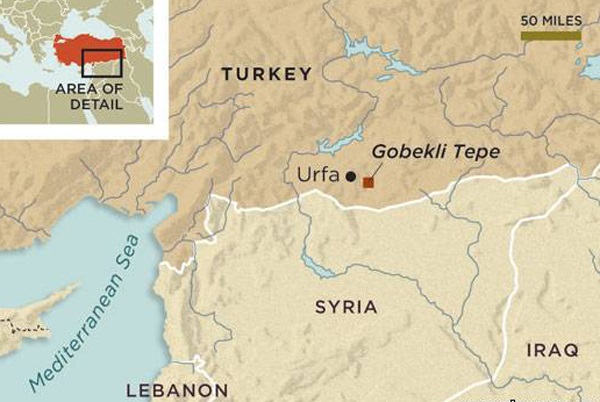| PURCHASE ON AMAZON |
Göbekli Tepe
See also Yezidism
11,000 -,9,000 BC
From ... http://ngm.nationalgeographic.com/2011/06/gobekli-tepe/mann-text
The Birth of Religion
We used to think agriculture gave rise to cities and later to writing, art, and religion. Now the world’s oldest temple suggests the urge to worship sparked civilization.
 "The assemblage was built some 11,600 years ago, seven millennia before the Great Pyramid of Giza. It contains the oldest known temple. Göbekli Tepe is the oldest known example of monumental architecture—the first structure human beings put together that was bigger and more complicated than a hut."
"The assemblage was built some 11,600 years ago, seven millennia before the Great Pyramid of Giza. It contains the oldest known temple. Göbekli Tepe is the oldest known example of monumental architecture—the first structure human beings put together that was bigger and more complicated than a hut."
"Construction of the site would have required more people coming together in one place than had likely occurred before. Amazingly, the temple's builders were able to cut, shape, and transport 16-ton stones hundreds of feet despite having no wheels or beasts of burden."
"These people were foragers," Schmidt says, people who gathered plants and hunted wild animals. "Our picture of foragers was always just small, mobile groups, a few dozen people. They cannot make big permanent structures, we thought, because they must move around to follow the resources. They can't maintain a separate class of priests and craft workers, because they can't carry around all the extra supplies to feed them. Then here is Göbekli Tepe, and they obviously did that."
"The construction of a massive temple by a group of foragers is evidence that organized religion could have come before the rise of agriculture and other aspects of civilization. It suggests that the human impulse to gather for sacred rituals arose as humans shifted from seeing themselves as part of the natural world to seeking mastery over it. When foragers began settling down in villages, they unavoidably created a divide between the human realm—a fixed huddle of homes with hundreds of inhabitants—and the dangerous land beyond the campfire, populated by lethal beasts."
"Schmidt speculates that foragers living within a hundred-mile radius of Göbekli Tepe created the temple as a holy place to gather and meet, perhaps bringing gifts and tributes to its priests and craftspeople. Some kind of social organization would have been necessary not only to build it but also to deal with the crowds it attracted. ... The temple was a spiritual locus, but it may also have been the Neolithic version of Disneyland."
""Twenty years ago everyone believed civilization was driven by ecological forces," Schmidt says. "I think what we are learning is that civilization is a product of the human mind.""
| Attachment | Size |
|---|---|
| 77.83 KB |
- Log in to post comments

